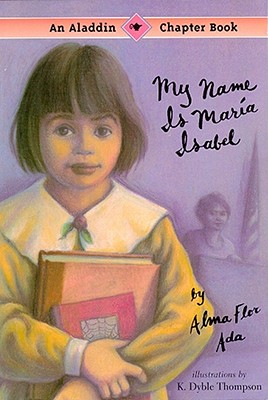Sometime this year you will meet someone who is a refugee. What can you do that might make a difference?
Say “hello.”
Anyone different is scary – we glance away from someone in a wheelchair or who has only one arm. We look down when our eyes meet someone with a bald head or who is wearing a scarf – different makes us glance away, step back, or hurry past.
Instead, smile and say hello.
What if you are a newly relocated refugee coming from a country that no one has heard of and nobody knows how to pronounce your name? As a refugee, you have left behind “home” – your friends, clothes, language, even your name.
Honor their name. Ask how to pronounce the name correctly. Say it out loud. Ask what their name means and perhaps who gave them their name. Every name has a story. Most everyone wants to share the story about their name.

We are reminded by Alm Flor Ada about the importance of one’s name in MY NAME IS MARIA ISABEL.
MY NAME IS MARIA ISABEL by Alma Flor Ada.
María Isabel is a new student in a classroom that already has several “María’s.” Her teacher suggests that, to avoid confusion, this new María will be called Mary.
But one’s name is who one is – within family, at school, and within one’s culture. And that should not ever be taken away.
María Isabel learns that keeping her name is part of honoring and celebrating who she is.

MY NAME IS SANGOEL by Karen Lyn Williams and Khadra Mohammed, illustrated by Catherine Stock is a powerful picture book which shows the depth of a child’s feelings about their name. (http://www.karenlynnwilliams.com/sangoel.html)
A refugee from Sudan, Sangoel arrives in the United States with almost nothing except his mother, sister and his name. How frustrating it is for Sangoel that no one pronounces his name correctly nor understands that his name is much more – it is a heritage, a link to his family, home and ancestry. Sangoel creates a clever solution which becomes an important first step in creating a community of friends in his classroom.
Karen Williams, author of several award-winning picture books that show the experiences of refugee children, has many simple practical suggestions we all can do:
“I think one of the best things a child can do is make sure the refugee student finds where to go in school, how to get to different places, rooms, cafeteria and sit with them during lunch.”
“Just being a friend helps. Refugee children often do not know how to respond to friendship invites and gestures. Their costumes are so different. Here is where an adult can help.”
“Personal space needs are different in every culture. Standing too close can aggravate others. As an adult, explain to a child that others need more “space.”’
“Many students will make fun of refugees because they are different. It is difficult to stand up for them in the face of bullies. Try not to be part of the teasing.”
“Ask about their clothes, their religion, their home and experiences getting to your town. Some of these things will be too difficult for the refugee to talk about. And there may be a language barrier. Again the best thing you can do is to understand that refugees have been forced to leave their homes. They did not come to the US by choice. They might be thankful that the US has taken them in but they may also be grieving about their family and friends who have been left behind.”
“Parents, with your children, offer rides to everywhere – supermarket, doctor’s appointments. Show them how to use the bus system.”
“Invite them to your home, take them on special outings like to the playground, sledding, movies. Understand that events we find special might be very frightening. Some hosts took Somali families to the fireworks for Fourth of July which was a terrifying experience – fireworks meant war.”
“It is helpful to ask, “Is there anything you do not understand that we can help with?” A visit on a regular basis could be a big help so the families know that you will be coming and they can ask you to read their mail, interpret, or explain about bills and so on. Of course much of this is for adults but it is a good family activity.”
“Childcare for a few hours is another way to help so the parents who are in shock and trying to figure out everything about a new life can have a break or take care of things they need to do.”
“Offer some used toys or share some games — bicycles, skate boards, scooters are great.”
And remember – call them by name! One important possession refugee children do not have to lose is their name.
Nancy Bo Flood
4 comments for “Refugee Children – What can I do?”